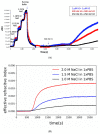Biosensing Amplification by Hybridization Chain Reaction on Phase-Sensitive Surface Plasmon Resonance
- PMID: 33800935
- PMCID: PMC7998988
- DOI: 10.3390/bios11030075
Biosensing Amplification by Hybridization Chain Reaction on Phase-Sensitive Surface Plasmon Resonance
Abstract
Surface Plasmon Resonance (SPR) is widely used in biological and chemical sensing with fascinating properties. However, the application of SPR to detect trace targets is hampered by non-specific binding and poor signal. A variety of approaches for amplification have been explored to overcome this deficiency including DNA aptamers as versatile target detection tools. Hybridization chain reaction (HCR) is a high-efficiency enzyme-free DNA amplification method operated at room temperature, in which two stable species of DNA hairpins coexist in solution until the introduction of the initiator strand triggers a cascade of hybridization events. At an optimal salt condition, as the concentrations of H1 and H2 increased, the HCR signals were enhanced, leading to signal amplification reaching up to 6.5-fold of the detection measure at 30 min. This feature enables DNA to act as an amplifying transducer for biosensing applications to provide an enzyme-free alternative that can easily detect complex DNA sequences. Improvement of more diverse recognition events can be achieved by integrating HCR with a phase-sensitive SPR (pSPR)-tested aptamer stimulus. This work seeks to establish pSPR aptamer system for highly informative sensing by means of an amplification HCR. Thus, combining pSPR and HCR technologies provide an expandable platform for sensitive biosensing.
Keywords: aptamer; hybridization chain reaction; phase-sensitive surface plasmon resonance (pSPR) biosensor.
Conflict of interest statement
The authors declare no conflict of interest.
Figures





Similar articles
-
An enzyme-free surface plasmon resonance biosensing strategy for detection of DNA and small molecule based on nonlinear hybridization chain reaction.Biosens Bioelectron. 2017 Jan 15;87:345-351. doi: 10.1016/j.bios.2016.08.077. Epub 2016 Aug 24. Biosens Bioelectron. 2017. PMID: 27587359
-
Target-triggering multiple-cycle amplification strategy for ultrasensitive detection of adenosine based on surface plasma resonance techniques.Anal Chem. 2015 Jan 20;87(2):929-36. doi: 10.1021/ac503016f. Epub 2014 Dec 24. Anal Chem. 2015. PMID: 25494977
-
Surface plasmon resonance biosensor for sensitive detection of microRNA and cancer cell using multiple signal amplification strategy.Biosens Bioelectron. 2017 Jan 15;87:433-438. doi: 10.1016/j.bios.2016.08.090. Epub 2016 Aug 27. Biosens Bioelectron. 2017. PMID: 27589408
-
Hybridization chain reaction: a versatile molecular tool for biosensing, bioimaging, and biomedicine.Chem Soc Rev. 2017 Jul 17;46(14):4281-4298. doi: 10.1039/c7cs00055c. Chem Soc Rev. 2017. PMID: 28573275 Review.
-
Hybridization chain reaction and its applications in biosensing.Talanta. 2021 Nov 1;234:122637. doi: 10.1016/j.talanta.2021.122637. Epub 2021 Jun 23. Talanta. 2021. PMID: 34364446 Review.
Cited by
-
Loop-mediated isothermal amplification-based electrochemical sensor for detecting SARS-CoV-2 in wastewater samples.J Environ Chem Eng. 2022 Jun;10(3):107488. doi: 10.1016/j.jece.2022.107488. Epub 2022 Feb 28. J Environ Chem Eng. 2022. PMID: 35251932 Free PMC article.
-
Recent Advancements in Aptamer-Based Surface Plasmon Resonance Biosensing Strategies.Biosensors (Basel). 2021 Jul 10;11(7):233. doi: 10.3390/bios11070233. Biosensors (Basel). 2021. PMID: 34356703 Free PMC article. Review.
-
A Simple Phase-Sensitive Surface Plasmon Resonance Sensor Based on Simultaneous Polarization Measurement Strategy.Sensors (Basel). 2021 Nov 16;21(22):7615. doi: 10.3390/s21227615. Sensors (Basel). 2021. PMID: 34833688 Free PMC article.
-
Boosting the detection performance of severe acute respiratory syndrome coronavirus 2 test through a sensitive optical biosensor with new superior antibody.Bioeng Transl Med. 2022 Sep 16:e10410. doi: 10.1002/btm2.10410. Online ahead of print. Bioeng Transl Med. 2022. PMID: 36248235 Free PMC article.
-
Molecularly Imprinting-Aptamer Techniques and Their Applications in Molecular Recognition.Biosensors (Basel). 2022 Jul 29;12(8):576. doi: 10.3390/bios12080576. Biosensors (Basel). 2022. PMID: 36004972 Free PMC article. Review.
References
-
- He L., Musick M.D., Nicewarner S.R., Salinas F.G., Benkovic S.J., Natan M.J., Keating C.D. Colloidal Au-Enhanced Surface Plasmon Resonance for Ultrasensitive Detection of DNA Hybridization. J. Am. Chem. Soc. 2000;122:9071–9077. doi: 10.1021/ja001215b. - DOI
MeSH terms
Substances
LinkOut - more resources
Full Text Sources
Other Literature Sources

